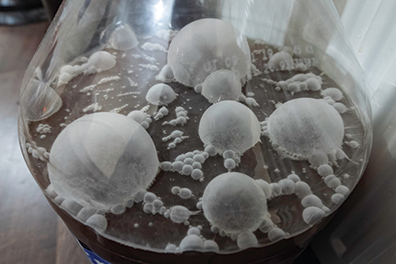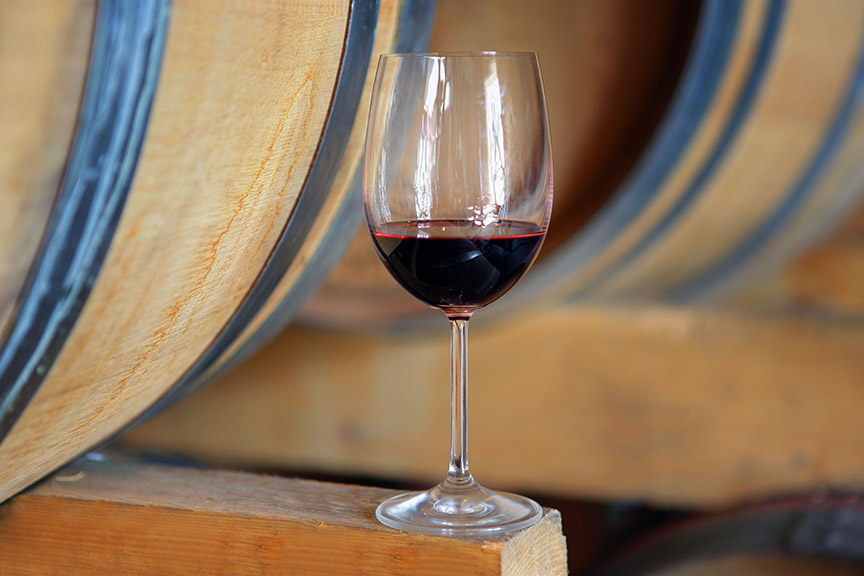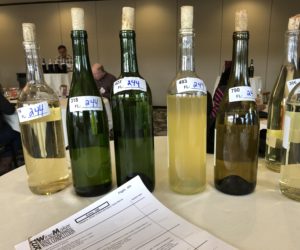
Some consider Brettanomyces a spoilage yeast. Some consider it the heart of the great wines of Bordeaux. Truthfully, it’s probably both.
I studied Brettanomyces for my master’s thesis at UC-Davis in the early ‘80s, so I’ve got quite a bit of information to share, hopefully some fresh and new. Before we dig into the impact it plays on wine and how to control it, let’s first explore variability in Brettanomyces, beginning with the diversity in morphology that confounds microscopy. Sometimes it looks like a stringy mycelium and other times just like a regular budding cell. Its signature shape, called “apiculate,” has a pointed end on one end and a flattened opposite end like a rowboat. You just never know what you’re going to get.
Brettanomyces vs. Dekkera
Sometimes you’ll hear this genus referred to as Dekkera. This is due to a very strange division that exists in mycology. We’re talking about the kingdom of the fungi and Brettanomyces (Brett) and Dekkera are classified in completely different families. Yet the only difference is that Dekkera produces sexual spores and Brettanomyces doesn’t. To me, it’s quite obvious that these are identical and it’s only the most vigorous strains that have the energy, if you like, to be able to reproduce through sexual spores. Otherwise, in all the physiology and morphology, the substrates they can metabolize and so forth, I think they’re the same thing and it’s ridiculous that they have different names assigned to different families. Don’t get me started.
Strain Variability
Brett/Dekkera is extremely variable in vigor. There are weak strains, strong strains, and everything in between. And it’s just crazy how much it varies genetically. Strains can be anywhere between 19 and 21 chromosomes. What species does that!?
Aromatic expression is quite variable as well, partly because of the difference in strains and partly due to the wine it’s growing in.
A study by the Australian Wine Research Institute found six different strains and mapped where you find them in the wine growing regions: Western Australia, Southern Australia, Tasmania, the Barossa, the Murray River, and the Hunter Valley, sometimes occurring in a mix — the Yarra Valley hosts three
different strains.1
Similarly, a study published by the Institut de Genetique et Microbiologie in France mapped six strains that they found in wine and beer in Europe.2 These strains appear to be spread through bulk wine trade within distinct regions. In particular, Bordeaux strains are almost completely different than the Burgundian strains, which makes sense given bulk wine trade between them is illegal. The result is differences in aromatic expression throughout the wine growing areas of the world.
The most celebrated aroma compound unique to Brett in red wines is 4-ethyl phenol. If you have an elevated amount of 4-ethyl phenol, then that probably indicates Brettanomyces. But that doesn’t mean that it’s the compound responsible for the aroma. 4-ethyl phenol does have an aroma: Band-Aid boxes used to smell this way before the glue formulations were cleaned up. Shoe polish is another reference that can be found. It’s really not a defect and it doesn’t smell anything like horse sweat, an aroma often associated with Brett. The barnyard descriptor is more similar to 4-ethyl guaiacol, which also has a smoky, meaty smell to it — think salami.
These two compounds are interesting because they synergize and as I’ll show you later, some red varieties have the precursor ferulic acid for 4-ethyl guaiacol. Even though it’s present in smaller quantities, (usually it’s 4-to-1 in favor of 4-ethyl phenol, or maybe 6-to-1), it varies with the variety (Cabernet Franc tends to be high in 4-ethyl guaiacol, the smoky meat character). But the two synergize and so the more you have of one, the more you can smell the other.
It’s an interesting phenomenon. 4-ethyl phenol and 4-ethyl guaiacol are only produced in red wine because the precursor for 4-ethyl phenol is coumaric acid and for 4-ethyl guaiacol it’s ferulic acid, and we don’t have those in white wines. So, white wines with Brett don’t smell the same way as red wines do. Brett is associated with a lot of other compounds that I believe are more important contributors to Brett’s defective aroma. Perhaps the most important is isovaleric acid, which smells like vomit. Then, adding to the mix, we’ve got volatile acidity. It doesn’t produce a whole lot, but it does tend to color the aroma.
Brett also can cause mousiness in wine by making tetrahydropyridines. Mousiness isn’t an aroma — you really only taste it about 30 seconds after you swallow the wine. Lactobacillus causes mousiness in grape juice if it gets hot in transport, but not in wine. These aromas are also found, or things like them are formed, by Pediococcus bacteria. So, Brett and Pediococcus are often confused, and they often occur together. And the classic for Pediococcus is sweaty socks, like a gym locker. In the case of Dekkera/Brettanomyces-induced mousy off-flavor, it appears that oxygen may play a key role. Thus, a wine infected with Dekkera/Brettanomyces in the absence of oxygen may not become mousy unless exposed to oxygen via a processing or handling procedure.3
Cunning Niche Strategies
In my thesis, I explored how clever this organism is. It has an array of strategies for causing secondary infection on the backs of other organisms, emerging only after Saccharomyces cerevisiae primary fermentation is done. It’s very well equipped to come on after that and then to hide out. To begin with, it has a very slow growth habit. Even under ideal conditions, colonies only emerge on agar plates after eight days, whereas Saccharomyces emerges within a day. It really likes heat and goes into hibernation below 59 °F (15 °C), and so you can have it in a cold cellar but it won’t actually show up until the wine, after bottling, is warmed to room temperature. Then often you’ll end up with a Brettanomyces bloom in the bottle. It’s very common.
Brett is also really good at sequestering itself. It will dig into wood and then when you go to steam-sterilize or ozonate the barrel, you’ll kill off all the cells on the surface, but that layer of dead cells actually protects the organisms behind them in a crack or crevice — for example, between staves. Another clever trait as a secondary infectant is that it needs essential micronutrients, in particular biotin and folic acid, that it doesn’t know how to make, so it can’t grow until those micronutrients are bled out from Saccharomyces cells as they die and then lyse themselves. In this way, it doesn’t try to compete, just showing up later on after other organisms’ activity has died down.
At that time, it possesses an incredibly wide ability to use different carbon and nitrogen substrates that other organisms, particularly Saccharomyces, cannot use. As long as there’s oxygen around, it can utilize ethanol as a sole carbon source for growth. It can also oxidatively metabolize proline, a ring structure that’s the most prevalent amino acid in both wine and beer, as a sole source of carbon and nitrogen. There’s a lot of it — three grams per liter, but most strains of Saccharomyces can’t utilize it. But Brett can. It can also utilize all the common sugars, both hexoses and pentoses, and also cellobiose — a sugar that doesn’t exist in nature but is created by toasting wood. That’s the reason that you get more Brett in a newly toasted barrel than you will in a used barrel. While a lot of winemakers like to put their wine in brand new barrels to avoid Brett contamination, the joke’s on them. In fact, they’re encouraging it.
Where does the Brett come from? The old adage says that there are two kinds of wineries: The ones that realize they have Brett and the ones that don’t. Brett is isolated in the wild from tree slimes and honey, which may explain why some wineries try to avoid bees during crush. I infer from the fact that Brett strains tend to limit themselves to regions trading in bulk wines that a common vector for infection is from wines or used barrels from other wineries. It appears highly infectious, like the common cold. And Brett seems ubiquitous, like athlete’s foot. You can’t get rid of it through sanitation, however draconian. My advice is to assume Brett is in your winemaking area and take steps to keep the population down, the way you keep your feet dry at the gym.
What steps work? Probably not what you think. Here’s my personal sad tale of woe. My thesis at UC-Davis involved isolating and characterizing 58 strains of Brett from California wineries. Then I looked at how much SO2 it would take to kill it. I grew up all these Brett strains in liquid cultures, then added SO2 in differing amounts to see how much it would take to drop the population six orders of magnitude in 24 hours. However, Charles Edwards, using the newly emerged PCR technology, discovered the phenomenon he named “viable non-culturable” — that SO2 does not actually kill Brettanomyces, but merely renders it un-plateable. The joke was on me. My work was really a complete waste of time because I wasn’t really killing the cells — I was just making them invisible.

Effective Defenses
Now that we understand Brett’s strategies, we can make wiser choices in defending against defective flavors and even enlist Brett in making great wine. It’s seldom a problem in white wine if standard rules for winemaking are observed, and even if not, it doesn’t create the same aromatics as in red wine, lacking the coumaric and ferulic acid components that are precursors for 4-ethyl phenol and 4-ethyl guaiacol. For this reason, the remarks that follow pertain to red wine only.
Let me offer a framework for our discussions. It’s useful to talk about the four phases of microbiological activity in wine. The first is prior to the onset of alcoholic fermentation by Saccharomyces, what we might call cold soak, though it could be at any temperature. Before the Saccharomyces has a chance to take over and create alcohol, a wide variety of low pH-tolerant yeast and bacteria too numerous to describe here can thrive.
In the second phase, Saccharomyces is the only yeast that can complete most alcoholic fermentations, though more and more non-Sacch. yeasts are appearing on the market for various purposes such as suppressing spoilage organisms, converting glucose to lactic acid, and producing complexing flavors. Whether or not commercial yeast inoculum is introduced, it is common for yeasts indigenous to the winery (not the vineyard) to participate in completion of alcoholic fermentation. These tend to be commercial strains that have made their way into the winery whether purchased or not.4
The third phase is the secondary fermentation converting malic acid to lactic. There are arguments to commence this during the alcoholic fermentation, though I tend to hold off until dryness, partly to prevent the risk of nutrient competition causing sticking, and partly because I like to perform micro-oxygenation at lower pH prior to malolactic fermentation.
The fourth phase is the realm of organisms like Brett and Acetobacter, Pediococcus, and also a lot of beneficial organisms. The indigenous microbiome from the cellar is much underappreciated. Much of it is beneficial in out-competing Brettanomyces and Pediococcus that if we sterilize the wine and take away the beneficial, then we will get a very strong Brett infection, much stronger than we would get if we hadn’t messed with Mother Nature.
Controlling Brett involves a three-legged stool. The first leg is to create a nutrient desert in the primary fermentation. Don’t overstimulate your yeast with excessive nutrients. It’s very useful to assess your yeast-assimilable nitrogen (YAN) and ammonia at the juice stage by sending off a juice sample to a lab a few days before harvest. You’re looking for around 150 ppm YAN. If you do need to make an addition, use a nutrient source that doesn’t contain DAP, an inorganic fertilizer that will speed your fermentation to dryness without consuming micronutrients. If you feed them Twinkies, they won’t eat their oatmeal.
The second leg is good structure. Spoilage aromas, over-oaking, and vegetal aromas are not problems of composition. Great wines have refined tannins and healthy color resulting from proper vine balance and harvesting ripe but not overripe, then effectively extracting co-pigmentation colloids and forming them (often with enological oxygen) into an elegant texture that integrates aromas.
The third leg is microbial balance. Red wine is not beer. If you’re a brewer, you may have picked up some bad habits because its high pH and low oxygen appetite makes it much more susceptible to bacterial spoilage, thus requiring ruthless sanitation. A well-made and properly stored red wine should have enough oxygen appetite to consume any dissolved oxygen and prevent both Acetobacter spoilage and the unfortunate side effects of oxidative Brett metabolism.
Here’s another scary story. When I was working with Oenodev in the ‘90s, we were the first to experiment with micro-oxygenation. People were concerned that small amounts of
oxygen would allow Brett to metabolize, for example, ethanol, and that we would encourage Brett growth. We set up an experiment to see whether that was true.
We filled 12 tanks with Merlot wine — this is in France — and inoculated six of them with Brettanomyces. The other six we didn’t inoculate. To run a rigorous scientific experiment, we flash-pasteurized wine, (high temperature for a short time) as we loaded the wine into the tanks so there wouldn’t be any other microbial interference. We ran different courses of micro-oxygenation in six treatment and control pairs to see whether the higher doses stimulated Brett growth.
Well, we had to abandon the experiment. Normally winemakers consider 500 cells/mL of Brett a serious infection. Guess what? Almost immediately, we got 107 cells/mL in all six inoculations!
And that’s when I realized that if you kill off everything in the wine, the Brett goes insane.
In commercial practice, Brett is an opportunistic pathogen — a hospital disease that appears when draconian sanitation eliminates the competition. For example, in sulfite-free wines, we really don’t have problems with Brettanomyces because everything is growing like crazy in those wines, which is actually protecting the wine from Brett.
Be kind to your microbiome. If you kill it off, you invite Brett to take over. Fostering your microbiome requires a cellar with a stable, moderate temperature and humidity. If you sterile filter wine and put it back in a barrel, then you’re really asking for trouble.
A Silver Bullet
In the event that Brett is rearing its head, several suppliers are making chitosan products that kill Brett cells by disrupting their cell walls (including No Brett InsideTM from Scott Labs, KillBrett® from Lamothe-Abiet, EnartisStab Micro from Enartis, Microstab Protect from Agrovin). This is a physical — not chemical — activity, thus it’s quite safe. Chitin is the structural material that crustaceans are made of as well as fungi including, in this case, Aspergillus niger, the black mold you see on the walls of old French cellars, so don’t be concerned with seafood allergies. Don’t confuse these products with the chitosans used for fining and clarification. These chitosans are also effective against Pediococcus and Acetobacter, and they’re good at preventing malolactic fermentation (MLF). On the other hand, if you want to put your wine through MLF, you better not put an agent like this in the barrel until after it is complete. But for whites where you’re trying to suppress MLF, they’re really great.
Here’s another experiment where we have Acetobacter in the control wine, you get an elevated level of acetic acid, whereas the treated wine keeps it down. It’s pretty cool stuff — generally suppressing microbiology and the three bad actors of Brettanomyces, Pediococcus and Acetobacter.
If you have access to reverse osmosis filtration, it can remove Brett character, but only it’s not going to work quite the way it does for acetic acid because these compounds are a little bit bigger, so we use a looser reverse osmosis filter. The permeate, instead of going through an anion resin, will go through a broad spectrum absorptive carbon here and then be returned to the wine. And unfortunately, your wine is going to take a hit.
Good Brett vs. Bad Brett
All the elements of diversity we’ve talked about contribute to whether your Brett occurs as a positive or negative: Which strain you’re dealing with, what variety, how well you’ve managed your nutrient desert and competitive microbiome, and how well the colloidal structure integrates the aromatics.
But a lot is personal preference. I was raised with French tastes, so I love stinky cheeses, fois gras, andouiette, and half shell oysters. The sexy bottle bouquet of a great Bordeaux is what got me into this crazy business. Many of my California winemaking colleagues disagree. They want nice clean fruit. I do, too, but just as a prerequisite. Like how the piano needs to be tuned, but then I want something soulful to be played on it.
And I learned something recently when comparing a great Cabernet Sauvignon from the ‘70s, whose owner had insisted on sterile filtration, against a sample the winemaker had siphoned out of the barrel. The commercial wine, while in great shape, hadn’t aged at all. The barrel sample, on the other hand, was one of the most stunning examples of profound bouquet I have ever smelled. That’s when I learned that the development that we expect in a bottle is really microbiological.
Most of my colleagues are afraid to make wine like that. There’s a widening gap between French winemaking, which was worked out centuries before sterile filtration even existed, and the style of wine pursued here in the Golden State. This is the reason I think good home winemakers make America’s best wines. You’re probably not set up to sterile filter even if you wanted to.
References:
1 Brett-strains-map (2014) The Australian Wine Research Institute. www.awri.com.au/files/attachment/brett-strains-map/
2 Cibrario, A. et al. (2019) Brettanomyces bruxellensis wine isolates show high geographical dispersal and long persistence in cellars, PLOS ONE. www.bit.ly/Europe_Brett_Strains
3 Snowdon, E. et al. (2006) Mousy off-flavor: a review, Journal of Agricultural and Food Chemistry. www.bit.ly/Mousy_Review
4 ETS Labs (2016) Winemaker’s Quarterly Vol. 2 issue 3, Issuu. www.issuu.com/etslabs/docs/winemaker_s_quarterly_v2i3_issuu







